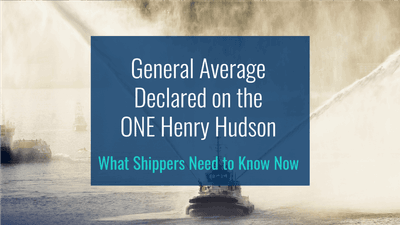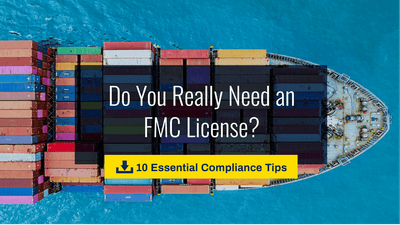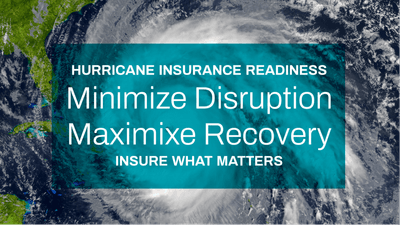September 15, 2020 | Cargo Insurance, Industry Insights
Insuring the Complicated World of Today’s Warehousing Business

By Rick Bridges (VP, Client Development) and Grant E. Goldsmith (VP, National Accounts)
Warehousing risk is complicated with multiple stakeholders involved in the supply chain with varying levels of responsibility for the cargo. To effectively put together solutions to finance risks, warehouse providers require an insurance broker who understands not only their business but also the complexity of modern warehousing. It takes a broker who comes with the expertise, creativity, and insurer relationships to move beyond what has been traditionally done and can think outside the box. Roanoke’s Rick Bridges, VP, Client Development, and Grant E. Goldsmith, VP, National Accounts, provide critical insights into what it takes to assess and manage warehouse risk today.
Inside the Warehouse Insurance Market
The warehouse insurance market today is considerably smaller in large part due to corrective action by the industry to improve underwriting profitability. “Lloyd’s of London last year mandated that its Syndicates stop writing unprofitable business,” explained Bridges. “COVID-19 further exacerbated the market’s restrictions. You now have underwriters limiting their quotes to low-risk accounts and reserving capacity for risks supported by a great deal of underwriting data. This has caused a decrease in the supply of warehouse insurers. Our strength is in having relationships with carriers ready to write the coverage and being creative in building a program. In some instances, particularly for a large warehouse, it may mean working with three to four insurance companies or Syndicates to come together on a risk.”
“The middle warehouse market in particular is feeling the squeeze, as it comes with risk but without much premium behind it,” added Goldsmith. “We’re seeing growth in the small to medium segment due to the growth in final-mile delivery services with no insurance market willing to serve it effectively, again reinforcing the need to work with insurance professionals who have strong carrier relationships committed to the space.”
Insurance Scalability Is Key
In procuring warehouse insurance, a customer needs a partner who has the ability to scale coverage based on need. “Just as a warehouse has to scale its operation to address fluctuating values throughout the year, so does the policy in place,” explained Goldsmith. “Typically, there are seasonal periods where an operation has high values at risk and other times when the warehouse may be at half capacity. In lieu of purchasing coverage with the highest possible limit when it’s not needed every day, scalable insurance solutions that are easy to manage should be put into place.”
It’s also important to work with a broker committed to providing a long-term insurance solution rather than having to change coverage annually or every couple of years. “This is particularly important because when you work with someone who understands the warehousing business and the types of business relationships the warehouse providers enters into, you are better able to provide solutions that address those varying relationships,” said Bridges. “Warehouse operators don’t have the time to train insurance professionals on the ins and outs of their business.”
Main Risk Factors in Warehousing Goods
Fire is the principal hazard for warehouses, including even those operations that have been regularly inspected and score well on risk surveys. “It can begin as a small fire, ignited by a coffee pot or hot glue gun, and become catastrophic as a result of a number of factors including failing to undertake certain risk-mitigation measures,” said Bridges. “For example, there may be a lack of firewall protection to compartmentalize the warehouse. Or, perhaps there isn’t a fully manned fire department nearby to respond quickly and minimize the loss.”
Bridges also explained that water damage is a significant risk for warehouses. The older wet sprinkler systems, when hit by a forklift or burst from freezing, can be disastrous and destroy substantial inventory, particularly during off-work hours when visibility to sprinkler activation is not immediately available. It’s important to have a good sprinkler maintenance plan in place. In addition, newer, dry sprinkler systems allow for water to remain at the floor level and prevent water from entering the pipes until a fire causes one or more sprinklers to operate.
“Engineering and location factors are a lot more significant for a warehouse than goods that move,” said Goldsmith. “In normal logistics where you are just insuring goods while in transport, [such goods] have lower values most of the time, so the same focus on the structure of the temporary storage doesn’t exist. When you are looking at static storage in a warehouse where inventory is maintained, the engineering components of the building and the surrounding areas become very important. For example, is the warehouse adjacent to an chemical or processing plant that is combustible. Does it have good access to city-based industrial fire prevention or is it near a small volunteer department?”
Theft is another hazard faced by warehouses, making physical security measures and employee screening critical. Most thefts, unfortunately, are inside jobs where employees alert thieves when the cargo is being loaded and made ready for transport. Closed circuit TV has been the biggest game changer not only in reducing inside theft, but also in reducing workers compensation claims as well.
Theft can also occur when a warehouse releases goods to a “fake carrier” or “coyote carrier” who steals the identity of the intended motor carrier and then picks up a legitimate load from a warehouse. This kind of loss is not typically covered under standard Crime Insurance. Identity theft losses within logistics are one of the fastest-growing causes of loss and need to be part of an active risk management strategy.
In coastal areas, warehouses are high on the list for supply-chain disruption during a hurricane, facing wind and flood damage from storm surges that could destroy the building and its inventory. It’s critical to identify facilities in high-risk areas to prepare for the worst, which includes maintaining a consistent system for monitoring weather every day along the supply-chain footprint, and having an emergency plan ready to move goods. Many warehouse insurance products do not offer catastrophic risk coverage for these events and, if they do offer coverage, it is often sub-limited to an amount insufficient to cover the values at risk.
Contract Review: Don’t Move Forward Without It
Determining a warehouse’s liability and what insurance solutions are available begins with the terms and conditions of the contract (master service agreement). “Historically, we looked at the bills of sale to determine who sold the goods and who was ultimately responsible for protecting them. Because today’s supply chain is very fractured and there are so many unique contractual relationships, we no longer can follow that old-school model,” emphasized Goldsmith. “Each contract for every single deal must be reviewed to determine where the warehouse is taking on risk and for how much. An insurance broker has to be able to help the underwriter better understand the structure of the agreement and propose solutions that fit within the client’s budget. The broker also has to be able to advise a client not to accept certain risks, as the cost to assume the risk is simply greater than what the client can withstand. Additionally, it’s important to underscore when insurance is not available, if the contract should be renegotiated, and actions should be taken to reduce exposure.”
Cargo owners, in fact, are increasingly transferring their liability to warehouse providers, as insurance costs increase and they believe the warehouse provider can obtain coverage at a lower cost. “We’ll go back to the shipper and explain why another solution may make sense, including whether the shipper should be purchasing coverage for their own goods. Warehouses are often taking on more risk and may not realize it. We serve as an advocate to help uncover their exposures,” said Bridges. “Contract review is the number-one priority in the risk-management process.”
The fallout from failure to review a contract is not apparent until there is a claim. “A warehouse or forwarder may have signed a storage contract without speaking to their risk manager or broker,” said Bridges. “If the underwriter was unaware of the situation when writing the coverage, the claim can be denied.”
Warehouse Legal v. Bailee v. All-Risk Coverage
Warehouse Legal Liability is the most basic insurance policy available, providing coverage in the event the warehouse is responsible for the damaged goods, up to a certain limit. Bailee insurance provides liability for goods damaged by the warehouse, which can be covered up to the full value of the merchandise. All-Risk insurance covers physical loss or damage to goods regardless of whether it’s the warehouse’s responsibility, including acts of God, theft, etc. on a full-value basis.
“In looking at a warehouse’s liability risk it’s important to dig deep to determine exactly what the provider agreed to in order to determine the coverage to procure. Again, you want to see what the contract says. If it’s a large customer generating significant revenue for the warehouse, you also consider the customer’s expectation in the event of loss to help determine what type of policy to purchase. The problem is the insurer will provide coverage based on the contract. It’s important for the warehouse operator to let us know what they want to cover and to understand the customer’s expectation so we can align the contract with the coverage,” said Goldsmith.
Insurance & Keeping Pace with Warehouse Modernization
When asked if the insurance industry has met the needs of today’s modern warehouse operation, Goldsmith explained that in many cases it hasn’t. “You have many legacy insurance products that don’t address a warehouse’s modern risks. A boiler plate property policy will not cover the various exposures involved due to the many intermediaries in today’s supply chain. It requires customization and looking at things differently to come up with solutions that go beyond what was traditionally done in the past. We work with our in-house underwriters and other carriers that are open to undertaking risk differently. Our experience and expertise provide underwriters with the confidence in our ability to develop solutions that work in today’s environment.”
Emerging technologies in modern warehouses serve to improve a client’s risk profile. This includes the use of drones for inventory and security. Sensors provide environmental monitoring of cargo while the goods are in storage as well as while they’re moving through the supply chain and stored at multiple warehouses. “Your cargo can now ‘talk’ to you and provide environmental information along the way, which can be done relatively inexpensively,” noted Bridges. “You gain greater visibility of the goods as they travel and can be better prepared if a natural catastrophe, like a hurricane, is on its way. For example, you can redirect goods in the path of an upcoming storm.”
Main Warehousing Business Models in Use Today
Foreign Trade Zones (FTZs)
FTZs, a duty-deferment vehicle, are utilized by warehouses to park merchandise without first having to pay duties and taxes. “If you are involved in international trade where you purchase goods from one country, bring them to the U.S. to either sit or be modified only to be shipped back out of the USA, a FTZ enables you to do so without having to pay duties and taxes,” explained Bridges. “Duties and taxes on international goods are only paid when released in the U.S. supply chain. Should goods be released in the U.S. without duties and taxes being paid, the FTZ bond covers the exposure of the U.S. Government.”
Consignment Inventory
Consignment inventory is increasingly utilized in today’s e-commerce model, with the owner of the goods retaining ownership while the products are being warehoused up until they are sold. This creates both a challenge and an opportunity. “The challenge is you may potentially have thousands of vendors with an exposure in that warehouse location. Many vendors are unaware that warehouses traditionally limit liability and therefore the goods are not fully insured. This becomes an opportunity for a warehouse that can offer an insurance solution to provide coverage for the full value of each vendor’s goods,” said Bridges.
The Role of Bonds and Surety in Warehouse Risk Management
Different regulatory authorities are involved in warehousing with a surety solution typically required. Both Bridges and Goldsmith stressed the importance of knowing that an insurance broker has the ability to reach the surety markets and understand the unique bond products that serve the warehouse industry – from Customs bonds to Foreign Trade Zones and Individual Commodity bonds (such as liquor, fire and ammunition bonds). “Working with a broker and surety who understands the client’s needs can’t be overstated. If a surety doesn’t understand a certain risk, a relatively easy bond underwriting process can be made difficult for an insured,” explained Bridges.
“It’s a financial product at the end of the day,” said Goldsmith, and “since you are already providing financial information to your insurance underwriter, the same information can be used to help with obtaining a bond. You want to be able to procure your insurance with a professional who can also help you with your surety needs.”
A key takeaway when it comes to insuring against risk is to work with an experienced, knowledgeable broker in the warehouse and logistics sector – one who understands that each risk is unique and is able to develop creative solutions to address today’s financial environment. “You have to be flexible today,” commented Bridges. “Warehousing [providers], are required to structure different arrangements, for a variety of commodities, sharpening their pencil along the way, with the liability, risk and insurance component just as much a variable to the discussion as square footage, the cost of hire, etc. You need an advocate working for you who is willing to invest the time in assessing the challenges and developing solutions to better fit the current environment.”
Roanoke: Providing Creative Solutions for Transportation Intermediaries and Logistics Service Providers
Roanoke understands the intricacies of Cargo insurance and Transportation Liability for logistics providers, and is strategically positioned to guide you through this complex process. Find out how we can provide you with the insurance programs you need to be properly protected. Please contact us at 1-800-ROANOKE or complete the Contact form located above.













